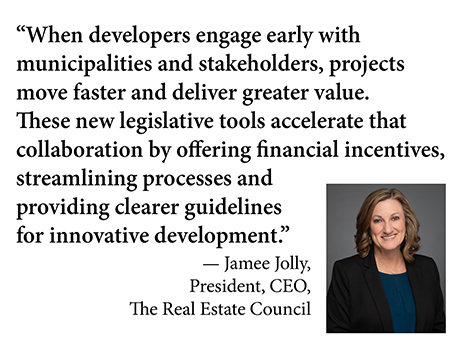By Jamee Jolly, president and CEO, The Real Estate Council
With record population growth and a $2.7 trillion economy, Texas faces mounting pressure to expand its housing supply and affordability. New legislation from the 89th legislative session gives developers, cities and investors new tools to build sustainable communities through stronger collaboration between the public and private sectors.
From established patterns of corporate relocations, job creation and direct foreign investment to fostering emerging industries like renewable energy, semiconductor manufacturing, aerospace and financial services, Texas has a long history of economic strength, industry diversification and innovation. That track record makes it one of the nation’s premier destinations for both businesses and residents.

Last year, according to U.S. Census Bureau data, Texas led the nation in population growth for the 14th consecutive year, adding more than 560,000 people to reach over 31 million statewide. In North Texas, the population in Dallas-Fort Worth (DFW) alone is expected to grow from 8 million to 12 million residents by 2050.
While this growth fuels one of the world’s largest economies, it has also created a shortage of more than 320,000 homes and a rising challenge of housing affordability statewide, particularly at the entry-level price point, where demand is highest.
Fortunately, state lawmakers recently implemented several landmark bills to address longstanding hurdles for residential developers, including restrictive zoning rules, infrastructure funding gaps, adaptive reuse opportunities and lot-size requirements. These aim to provide both immediate and long- term, sustainable housing solutions that will support our state’s continued growth.
What The New Laws Do
The 89th legislative session saw nearly 9,000 bills filed, making it the busiest session in more than three decades. Fewer than 1,400 of those bills passed, and several that passed will significantly impact the future of public-private partnerships and both commercial and residential real estate development as we know it.
Among those is House Bill 24, which aims to streamline the approval process for new residential construction.
Before House Bill 24, a century-old law allowed homeowners within 200 feet of a proposed zoning change to halt said change with only 20 percent of homeowners signing a petition and requiring a three-fourths supermajority vote for approval at the city council level. The result meant stalled housing growth and worsening affordability.
Under the new law, 60 percent of homeowners must now sign a petition to block proposed zoning changes of developments with a residential component. Even then, local governing bodies can approve it with a simple majority vote.
For developers, House Bill 24 marks an important step toward removing hurdles that can create delays, resulting in more costs.
Then there is House Bill 21, which expands access to financing and affordability tools.
Housing finance corporations (HFCs) are critical initiatives for financing new and refurbished rental housing units targeting low- and moderate-income Texans. In Dallas, for example, the Dallas Housing Finance Corp. (DHFC) oversees a portfolio of more than 30 projects representing billions of dollars in affordable housing investment. In 2023 alone, DHFC approved and closed five projects in southern Dallas totaling approximately $304 million in investment and nearly 1,300 affordable units.
Following reforms to Public Facility Corp. (PFC) tax exemptions during the 88th legislative session, many developments done under PFCs shifted to HFCs. However, these HFCs, many of which are known as “traveling HFCs,” circumvented local input or approval processes and caused serious oversight concerns.
House Bill 21 closes those loopholes. The legislation defines clear areas of operation for HFCs, strengthens affordability requirements, mandates that half of the property tax savings go directly to rent reductions and enforces compliance monitoring of all tax-exempt HFC properties. In short, House Bill 21 effectively eliminates “traveling HFCs” and ensures that HFCs serve local communities and provide meaningful affordability for Texans.
Senate Bill 15 protects and encourages diversity in housing options.
Senate Bill 15 reduces minimum lot-size requirements for single-family homes in new subdivisions — from around 5,000 to 7,000 square feet in large cities to 3,000 square feet or less. Smaller lots mean lower land costs and savings for developers and, ultimately, the opportunities for more diverse and affordable housing options. Large cities like Dallas will see less impact, but this is a particularly meaningful change in other parts of the state.
Senate Bill 840 covers multifamily and mixed-use development “by right.”
Senate Bill 840 streamlines multifamily and mixed-use development in large cities by limiting local zoning authority. It allows multifamily construction “by right” in commercial-, retail- and warehouse-zoned areas, eliminating the need for rezoning requests and reducing restrictions on height, density, parking and setbacks. The bill also waives certain fees and studies for adaptive reuse projects, helping developers convert commercial buildings and zoned properties into housing more efficiently.
Senate Bill 785 promotes housing affordability through HUD-code manufactured homes.
Senate Bill 785 aims to curb discriminatory or overly restrictive municipal regulations that block new Department of Housing and Urban Development (HUD) homes, which are federally regulated, built to rigorous safety standards and offer a cost-effective housing solution for working-class Texans. The bill preserves local control while ensuring equal treatment for all residential uses within a zoning district.
Additionally, Senate Bill 785 includes exemptions for certain historic districts and properties under old restrictions predating January 2, 2025. This bill, along with the others mentioned throughout this article, supports greater access to affordable homeownership, enhances predictability for developers and residents and aligns local regulations with federal housing standards.
Opportunities for the Real Estate Community
For developers, investors and local leaders, these bills open the door to unprecedented collaboration. The conversation is shifting from unit counts and zoning variances to one that is about forming communities that offer diverse and desirable housing where residents cannot only work but also afford to live — a goal that will sustain Texas’ attraction and growth for decades to come.
The key is partnership — public and private sectors working together toward shared goals. When developers engage early with municipalities and community stakeholders, projects move faster and deliver greater value for everyone involved. These new legislative tools can accelerate that collaboration by offering financial incentives, streamlining processes and providing clearer guidelines for innovative development. In Dallas, we are seeing this partnership approach play out to benefit public and private shared goals.
Challenges, Considerations
No legislation is perfect, and implementation will be the true test. Local control remains a sensitive issue in Texas, and cities will need flexibility to adapt these programs to their unique needs and the needs of their community members.
Funding will also pose a challenge — particularly for infrastructure and workforce housing initiatives that require sustained investment. Developers must navigate new regulatory frameworks while ensuring that projects remain economically viable. As the industry embraces adaptive reuse and public-private partnerships, transparency and accountability will be essential to maintaining community trust.
These challenges underscore the need for ongoing dialogue between policymakers and the private sector — a conversation that organizations like The Real Estate Council (TREC) are well-positioned to lead. For more than three decades, TREC has united North Texas’ real estate, finance and development industries around a shared mission to build a stronger, more accessible region through leadership, advocacy and community investment. As Texas enters a new era of growth, TREC’s model of collaboration can offer a roadmap for how industry leadership can drive long-term, inclusive solutions.
A Shared Vision for Texas’ Future
At its core, this year’s housing legislation recognizes that growth and affordability are intertwined. Texas is already home to four of the nation’s largest cities — Houston, San Antonio, Dallas, Fort Worth — and that growth shows no signs of slowing.
To remain a national leader in areas like corporate relocations, job creation, renewable energy, technology, aerospace and finance, Texas must plan, finance and build intentionally. In doing so, Texas will address our state’s housing shortage ensuring affordability at every level.
These new laws provide the roadmap to do just that. By embracing the opportunity for collaboration and innovation, Texas can ensure that its next era of growth is not only bigger — but better — for every Texan.


